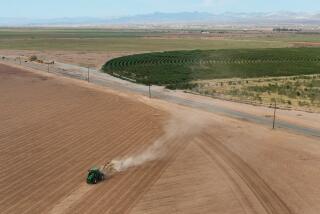La Nina May Affect U.S. River Flows
- Share via
Rivers in the Northwest and on the Eastern seaboard are likely to rise beyond normal levels this year, according to first-ever flood predictions based on the current La Nin~a cooling of the Pacific Ocean.
The forecasts also predict a greater likelihood of swelling in the rivers of the north central states and Appalachia but diminished chances in the Southwest and northern Mississippi River basin.
The predictions, which run through July, are the latest attempt to take climate data and translate them into usable forecasts. Researchers compared historical river flows to those of previous La Nin~a and El Nin~o events.
“We are sticking our necks out to a certain extent, but history seems to be on our side,” said Michael Dettinger, a U.S. Geological Survey research hydrologist and a study author.
It’s more likely the Southwest, New England, the western Gulf Coast and the upper Mississippi and Ohio River basins will see lower-than-average flows.
“This is a quantum leap. This is where the rubber meets the road,” said oceanographer William Patzert of NASA’s Jet Propulsion Laboratory. “This is hard information that industry will use in the next six months that will affect everybody’s lives.”
Dettinger believes the information will be more useful than simple weather forecasts, especially to agencies that manage water resources. But, he cautioned, a greater-than-normal flow does not always become a flood.
“Precipitation tends to just happen. Humans can’t get in the way of whether it’s going to happen or not,” he said. “But with stream flow, I can manage my reservoirs. A human can get in there and make a difference.”
Patzert, who studies El Nin~o and La Nin~a at JPL, said the predictions are part of “the big payoff” for investments in climate-monitoring technology and research.
“What all this powerful information has provided scientists is a much more detailed look at what the planet is up to,” he said. “It’s really improved our understanding. The real test of your understanding is whether you can actually forecast.”
El Nin~o is caused by the Pacific’s diminishing trade winds, which cause the ocean’s surface to warm. The most obvious effect is heavy rain in the Southwest as storms are energized by the warm water and the jet stream moves south into California.
La Nin~a forms when trade winds strengthen, causing cool water that normally exists along the coast of South America to extend westward. Sea-surface temperatures along the equator can fall as much as 7 degrees Fahrenheit below normal.
Because of the close relationship between ocean and atmosphere, the relatively cool water of the Pacific during La Nin~a squelches tropical storm formation and pushes the storm-carrying jet stream farther north.
“You end up with wet conditions in the Northwest and dry conditions in the Southwest,” Dettinger said. Historical records also indicate the East Coast tends to be wetter during La Nin~a years.
Researchers are less confident about their predictions for California, one of the most drought-sensitive states in the nation. The reason, they say, is that the line between the unusually wet Northwest and unusually dry Southwest splits the state.
“This is the conundrum we always face in California,” Dettinger said. “We really lie on a pivot point. In a particular year, what the outcome will be depends on small shifts north or south of the wetter-than-normal line.”
Last year the Northern Sierra received up to 140% of its normal snowpack. The Southern Sierra, on the other hand, got only about 80% of its normal snowfall.
Maurice Roos, California’s chief hydrologist, said the forecasts would be useful to water managers in areas where forecasters are confident. That’s not the case for California.
“Generalized indications are not very useful to us,” he said. “You can look at a weather map and get some idea of what to expect. . . . Hopefully, they can find other indicators that could give us a little more specific information.”






